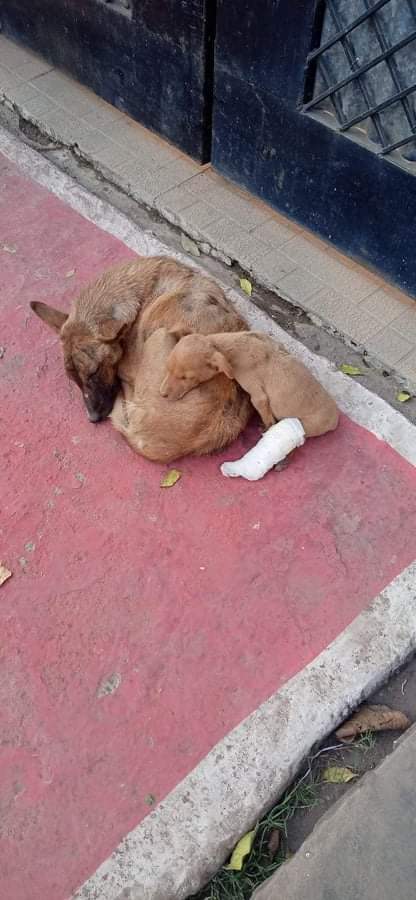Street dogs are an ubiquitous part of the Indian landscape. You can find them in every corner of India: picking through trash, running, fighting, playing, or sleeping. Usually they ignore humans altogether, aware of the danger they are in should they approach the wrong person. Street dogs tend to be overly cautious and warily eye newcomers. Yet, a small offering of food is enough to win over even the most timid dog for life. Streeties are a mix of all breeds, ancient and contemporary. Over millenia, Indian street dogs have formed their own psuedo-breed standard through natural selection: short coat, wide triangular ears that often stand upright, a curved tail, lean physique, and unwavering loyalty to humans who show them the slightest kindness.
With an estimated 35–40 million street dogs running freely in India, the population is exploding out of control. Left unchecked by the government and local populace, the dogs continue to breed at an exorbitant rate. Far too many street dogs die of untreated illnesses, wounds, or starvation. These dogs need help, but too few people are willing or able to provide them adequate care despite the dogs being an integral part of their communities.

Kaluu, the most popular street dog in our neighborhood!
Many dogs are much beloved and regularly visit their favorite houses to be spoiled or play with the local children. Kaluu (Blackie) is our local canine celebrity. He can be found on a doorstep here, a rooftop balcony there, or trailing protectively behind children at play. Immune to excited screams, neck hugs, or tail grabbing, Kaluu patiently lets the children hang all over him while exuding an air of serene complacency. Kaluu has a small gang consisting of his twin brother and a large brown and white female named Gingy. They make their daily rounds, begging for food and chasing off canine interlopers. Every house feeds the local dogs. Even if someone can only spare a single roti, it will be given to a friendly looking beggar. Instinctively, the neighborhood trades offerings of food for the communal dog’s watchful alertness and kinship.
The love of a well-fed street dog knows no bounds. Our local girl Momo always accompanies my son and I on walks outside of her territory, often to her own detriment. It’s heartening to have her loyalty, though I wish I could convey to her my dismay when she obstinately follows us to areas with dogs who have attacked or chased her. Despite my protestations about her entering hostile territory, she traipses behind us until she is forced to run for her life.


Most Indians wholeheartedly accept or graciously tolerate the presence of street dogs. However, much of the population is terrified of dogs and for good reason. India has the highest number of human rabies deaths in the world. Dog bites are the cause for 99% of rabies transmissions to people. Many people don’t understand the necessity to vaccinate against rabies, nor the fact that they must receive all 5 doses of the shot before symptoms occur in order to survive the disease. The series of shots can be expensive for many families, and vaccine costs may be a factor as to why rabies deaths are so prevalent in India.
In fear, people take to carrying sticks or throwing rocks at dogs as a deterrent. Sometimes it is a necessity, for a handful of vicious dogs do roam the streets and one must have a means of self-defense. For the most part though, people are overly fearful and cruelly throw rocks or beat any dog within their vicinity. Mangy-looking strays often bear the brunt of aggression by frightened humans because they look visibly “diseased.” Often dogs with mange starve to death because they are completely ostracized.

While undergoing treatment for mange, Stony was hit by a truck and died.
Due to their exponentially increasing population, the presence of street dogs has become heatedly contentious. Some people have cruelly taken to poisoning the food of dogs, leading to massive protests within India. Last week, 300 dogs were discovered lying dead in a pit in Andhra Pradesh. Mass slaughter of dogs undertaken by private citizens happens frequently, even though it is illegal to harm or kill dogs in India. According to the Indian government, dogs are protected from all forms of cruelty and it is a criminal offense to harm or kill a dog. It is also illegal to intimidate or harass those who feed community dogs, but that has not stopped angry mobs from trying. One family was held hostage in their car with their small child for close to five hours by a violent mob who accused them of feeding the area’s dogs.
The fear of being bitten without the ability to afford a life-saving vaccine makes life more difficult for both dogs and people. Not only is the populace woefully ignorant about rabies as an endemic disease, but there is no “Animal Control” available to actually do something should a rabid dog enter your neighborhood. We experienced this firsthand when a two-month-old puppy bit a woman in our neighborhood.
After the puppy bit our neighbor, my husband built a small enclosure to quarantine the puppy. Local authorities would do nothing. No vet would come to euthanize him, and we watched him die. Slowly. Over the course of days. He screamed in agony, mouth full of foam, while his throat constricted in spasms.
That puppy suffered as nobody ever should. We decided our family would get vaccinated as a precaution. We encouraged our neighborhood to do the same. For two weeks I lived in constant anxiety that somehow I had contracted the disease and would die horribly, despite being vaccinated (admittedly a rare occurrence, but my mind clung to the idea). The painful, resounding screams of that puppy still haunt me. I’ve never been able to look at dogs the same way. Every new dog I meet sparks that fear within me—”Is he/she rabid? Will I die?”

Since that day my husband and I have done our level best to vaccinate every dog in our neighborhood, as well as areas we visit frequently. We feed as many dogs as we can and give medication to mangy dogs we find. But we are only two people. It’s likely we’ve treated less than one percent of the city’s dogs despite our best efforts. Administering vaccines is dangerous and thankless work. We have to gain the trust of the dogs, catch them, tie them up, and call a vet to come and vaccinate them. It is always risky, but ultimately worth a safe neighborhood, a safe city, and safe dogs.
A more viable option to mitigate the issue of rabies and population control is for neighborhoods to pool money to vaccinate and spay/neuter their local dogs. Spaying/neutering local dogs will drastically reduce the dog population, as well as the threat of rabies transmissions. The presence of an established street dog will deter new unvaccinated dogs from entering neighborhoods, ensuring a bubble of safety for residents. Many people care deeply for their neighborhood dogs, and grassroots vaccination schemes would rapidly ensure the safety of dogs and people without bureaucratic red tape, government funding, or long-winded legislation.
If possible, street dogs should be adopted into loving homes where they can be cared for and kept safe. Street dogs are unfairly stigmatized, commonly thought of as tame wild dogs ill-suited for a life indoors. Street dogs can make terrific pets, but they must be well-socialized from a young age, since they tend to be quite territorial. Unlike breed dogs, street dogs don’t have a common temperament. Thus, some dogs are more well-suited for being house pets while others retain a wildness that cannot be trained. This is obviously not the case for all street dogs; but it is something to keep in mind should you be interested in adopting a street dog. International adoptions are currently on hold in some countries due to the pandemic, but charities are currently accepting applications and exporting adoptees to countries without restrictions.

Gingy would love to be adopted. Other dogs often attack her because she is so timid.
Unfortunately for most people living in India who do want to adopt, keeping a dog when you work 12–14 hour days is simply not an option. Dogs with homes are often kept chained to fences or in yards without respite or recourse. Moreover, there isn’t a “dog culture” in India that is conducive to easily keeping a pet dog (i.e. dog parks, public places where pet dogs are welcome, or even safe areas to walk leashed dogs). We have a large yard, but I often wonder if my own spoiled “house dogs” are jealous of the unlimited freedom of their communal counterparts.
I personally think many community dogs live a pretty good life—provided they are fed, given medical attention, and a warm dry place to sleep. Something about the ability to roam as they please seems more appealing than life on a leash to me, but that freedom does not come without costs. Puppies and dogs alike die after being hit by cars or trucks. If an accident victim is lucky, they survive but may live with a permanently mangled leg. It’s common but nevertheless heartbreaking to see street dogs dragging a crushed leg or limping on busy roads. Dogs in rural and suburban areas fare much better, but accidents still take place on the quietest of country roads.

A car hit this puppy. She managed to survive but her leg was fractured.
As harsh as their lives can be, the street dog prevails. Happily roaming in search of their next meal, the street dog is a modern relic of ancient times. If street dogs are vaccinated and sterilized can they be kept as they are–the perfect balance of wild and domesticated? Is there a compromise between a street dog’s freedom and quality of life? What can be done to preserve the integrity of the street dog without endangering humans or dogs? These questions often keep me awake at night. I don’t think there is one answer to any of them, but I believe local communities can band together and find unique solutions to the issues facing street dogs and the human populace without resorting to cruelty.
Get more like this—Sign up for our daily inspirational newsletter for exclusive content!
__
Photo: Jessi Ferguson




